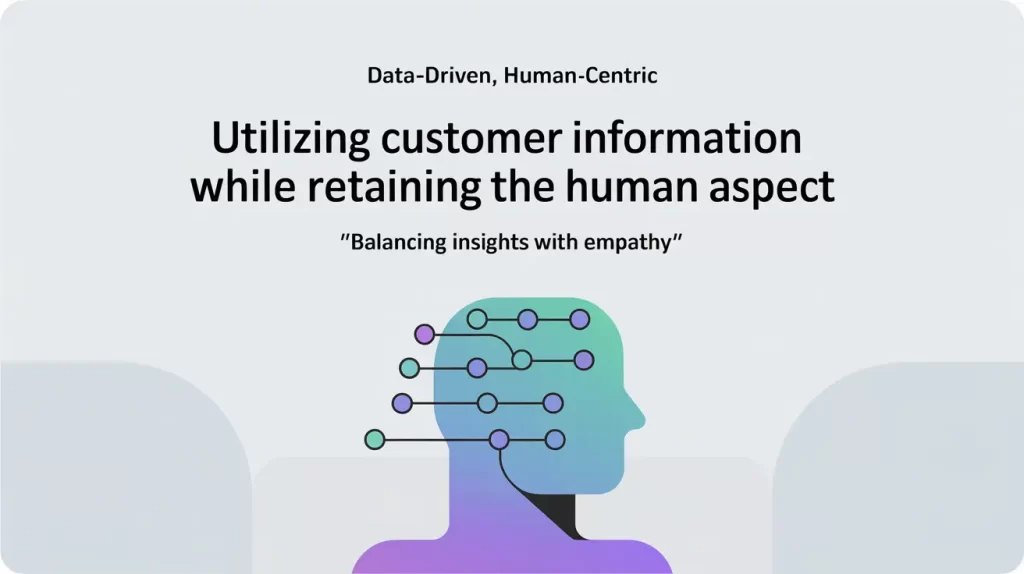In business, information has become a valuable asset almost equivalent to currency. It is actively used to identify consumers’ patterns, needs, and behaviors, and subsequently create impactful customer messaging for increased engagement. However, effective marketing campaigns can be far more nuanced than what data alone may suggest.
While analytics can help a business understand their audience better, they can never surpass the various emotional elements that only human-to-human interaction can identify. Shifting away from data-focused strategies and blending the human aspect into marketing strategies is what guarantees lasting customer relationships and improved brand credibility.

Table of Contents
How Businesses Can Effectively Use Data Collection
Now, more than ever, understanding your customers is critical for building a business that elevates above the competition and provides products and services that the market really needs. Data collection is critical to this effort. Based on the collected insights gained from customers, brands can create stronger engagement strategies that convert more business while creating an important sense of brand loyalty.
Below are some of the reasons why gathering data on customers is so important:
- Enhanced Marketing Communication – Executing your customer approach on a personal level is critical for modern businesses. It’s almost impossible to modify products, services, or outreach initiatives without gathering information about customers, especially when growing the business.
- Improved Decision-Making – All the steps taken toward developing and marketing a product rely heavily on the insights gained from data. Understanding what works, what doesn't, and where things can be improved empowers you to allocate resources more efficiently, optimize your Instagram marketing campaigns, and ultimately, increase ROI.
- Better Customer Relationships – Understanding customer needs on a deeper level translates to more significant interactions. Being able to better predict their requirements lets you address concerns quickly and create a more personalized service experience, building trust and long-term loyalty.
- Higher Quality Products and Services – Collecting information reveals unmet needs and market opportunities that might be easily overlooked. These insights become the foundation for growth, allowing you to create more high-value products or improve existing services to meet relevant user demands.
Different Ways to Obtain Important Business Information
Collecting customer data can be difficult for some businesses. Even if they do source useful data, using it correctly is a whole other story. However, when you combine many different data sources together, it can reveal even more useful insights for the business.
Below are some common places valuable business data can be stored:
- Company Website – Google Analytics and other comparable services let you see what goes on “behind the curtain” of your website. It shows how your visitors found your site (search traffic), how long they stayed on the site (session duration), and what they did on your various pages. This gives an overview of how users move throughout the site and what content keeps their attention the best.
- Social Media Platforms – The amount of likes, shares, comments, and reactions to a brand on social media has been important social signal for some time now. It reveals important trends that show how your brand and content are performing online based on the engagement received. In addition, there are online listening tools that track brand mentions for comparison against your competitors.
- Feedback From Customers – Gathering direct responses using surveys is one of the best methods of collecting information. Through these questionnaires, customers can give their impressions of their own experiences – how satisfied they are, what they hope for, and what improvements they want in your products. By customizing these surveys to specific touchpoints within a customer's journey with your brand, feedback can be even more relevant and actionable for the brand.
- History of Transactions – Transaction records may be easy to ignore, but they are filled with helpful information. Customers’ buying frequency, average order total, and what products they specifically prefer to buy are all shown on these records. Checking this data regularly gives the company a good overview of any apparent pattern in purchase history as well as better understanding the overall value a customer brings in over their lifetime.
Understanding Data Insights While Also Understanding Humans
There is no denying that data provides an immense amount of insight, but relying solely on it can lead to a robotic and detached experience with the brand. The goal is to utilize the potential that data offers while keeping the human element at the center of it all. Here are some steps to achieve that delicate balance:
Being Careful Not To Overstep Boundaries
Marketing has changed considerably over the years and customization is at the forefront of it all. However, there is a fine line that separates helpfulness and intrusive behavior.
There is a general acknowledgement among people today that they should be concerned about their online privacy. While providing relevant products and services to customers is helpful, always remember to avoid overstepping with aggressive advertisements.
This doesn't mean that using data is wrong. It does mean that transparency is key. Make it a point to highlight how customers’ data is collected. Always request to gain customers’ consent in a clear manner and give them control over how their information is used.
Balancing Quantitative and Qualitative Insights
Both hard data (quantitative) and personal feedback (qualitative) are essential. Blend your numerical analysis with customer reviews, stories shared on social media, direct comments, and survey answers to gain a complete understanding of various customer insights.
This approach allows you to explore the “why” behind the statistics you find, helping you to understand the underlying reasons behind a customer's actions.
Putting More Focus on Building Relationships
With the help of data, it's possible to create more unique customer experiences like personalized welcome messages or selected product recommendations.
Predictive analytics solutions that leverage customer data can be used to discover potential areas of intervention needed before any problems with customers occur.
Ensure That Your Company Keeps Focused On What's Important
It’s important to collect and analyze consumer data to be successful as a business. However, it is equally vital to relate well with clients on a personal level. This involves knowing how to apply data at the right time while still focusing on building strong relationships that lead to increased brand loyalty long-term.





